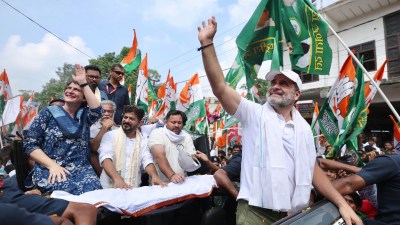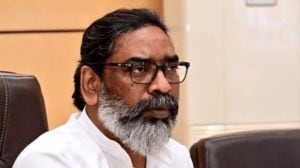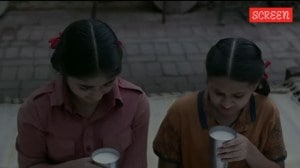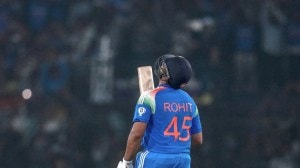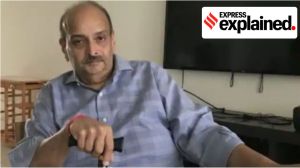Nation takes part in PM Modi’s nine-minutes ‘lights-off’ exercise, many burst crackers
As the clock struck 9, lights went out in most houses and people gathered in balconies and at doors, flashing mobile lights while many lit candles and diyas. Fireworks, thalis, whistles and police sirens were heard.
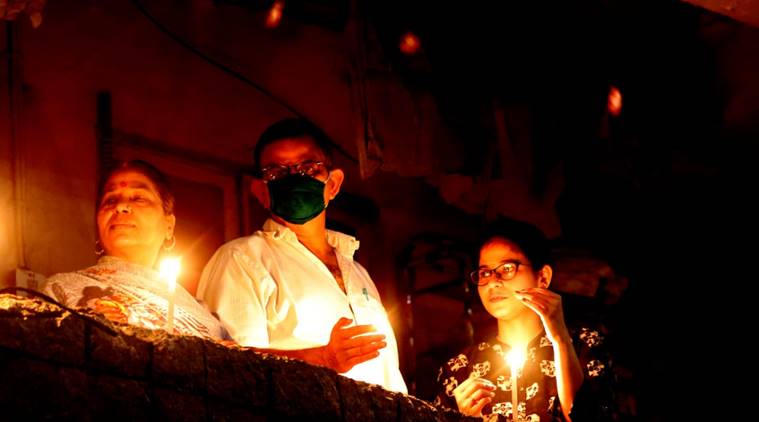 People stand in their balconies with candles to show solidarity against Coronavirus (Express photo by Ganesh Shirsekar)
People stand in their balconies with candles to show solidarity against Coronavirus (Express photo by Ganesh Shirsekar)
At 9 pm on Sunday, the country participated in the nine-minutes ‘lights-off’ exercise as per Prime Minister Narendra Modi’s call to display the country’s “collective resolve” to defeat coronavirus. Several people stood in their balconies in and lit lamps and candles. Many, however, also burst firecrackers and assembled outside their homes.
Prime Minister Narendra Modi also lit a candle as part of the no-lights exercise.
शुभं करोति कल्याणमारोग्यं धनसंपदा ।
शत्रुबुद्धिविनाशाय दीपज्योतिर्नमोऽस्तुते ॥ pic.twitter.com/4DeiMsCN11— Narendra Modi (@narendramodi) April 5, 2020
As the clock struck 9, lights went out in most houses and people gathered in balconies and at doors, flashing mobile lights while many lit candles and diyas. Fireworks, thalis, whistles and police sirens were heard. At some places, Hindu devotional songs, mantras and national anthem were also played. Earlier in the day, PM Modi had reminded people to light up lamps on Sunday night. “#9pm9minute”, the PM tweeted to remind people of the exercise.
Scenes from Chennai! People bursting crackers! #9pm9minutes @IndianExpress pic.twitter.com/9w8kb8ZnBC
— Janardhan Koushik (@koushiktweets) April 5, 2020
Meanwhile, grid operators across states have planned an elaborate set of contingency measures to avert any crisis caused by the sudden massive load reduction due to the exercise quickly followed by a sharp increase.
Defence Minister Rajnath Singh lights up earthen lamps along with his family. PM had appealed to the nation to switch off all lights of houses today at 9 PM for 9 minutes,& just light a candle, ‘diya’, or flashlight, to mark India’s fight against #Coronavirus pic.twitter.com/EB5nFzu9xO
— ANI (@ANI) April 5, 2020
Prime Minister Narendra Modi’s appeal had on Friday urged people to switch off the lights at their homes and light up lamps, candles or mobile phone torches for nine minutes at 9 pm on April 5 to “illuminate the common purpose we are all fighting for” and challenge the darkness of the coronavirus crisis with the “glory of light”.
At 9 pm Sunday, a family of three residing on the streets lit up a diya as they finish their meal (rice and potatoes). They have been out of work since the lockdown
“We stand together, It’s a hard time for the country with the virus,” the woman said. @IndianExpress pic.twitter.com/KbypGGKddf— Aishwarya Mohanty (@pirouetteworld) April 5, 2020
This comes two weeks after citizens clapped, rang bells, and beat utensils to thank the providers of essential services during the Janata Curfew of March 22.
“Amidst the darkness spread by the Corona pandemic, we must continuously progress towards light and hope. We must continuously strive to take those of us most affected, our poor brothers and sisters, from disappointment to hope,” the Prime Minister had said, adding “we must end the darkness and uncertainty. by progressing towards light and certainty. We must defeat the deep darkness of the crisis, by spreading the glory of light in all four directions.”
Ministry clarifies: Only switch off lights, not other appliances
The Ministry of Power has clarified that the PM’s appeal is to only switch off lights and not other appliances. The statement said, “The appeal of the Hon Prime Minister is to simply switch off the lights in their homes from 9 pm to 9.09 pm on April 5. There is no call to switch off either street lights or appliances like Computers, TVs, Fans, Refrigerators and ACs in the homes.
Scenes from Chennai! #9pm9minutes @IndianExpress pic.twitter.com/bMxIxOQV4c
— Janardhan Koushik (@koushiktweets) April 5, 2020
“The lights in Hospitals and all other essential services like Public Utilities, Municipal Services, Offices, Police Stations, Manufacturing Facilities, etc will remain on…All local bodies have been advised to keep the street lights on for public safety.” PIB Principal Director General KS Dhatwalia also appealed to people to not use alcohol-based hand sanitisers before lighting candles.
India is one of the largest synchronous interconnected grids in the world, with an installed capacity of about 370 gigawatts (3,70,000 mega watts), and a normal baseload power demand of roughly 150 gigawatts.
Grid managers on alert
In response to the PM’s appeal, grid managers across states such as Punjab, Uttar Pradesh, Gujarat and Tamil Nadu, though their respective state load despatch centres (SLDCs) are learnt to have flagged the risks and are preparing for the worst case scenario as a contingency measure, with the assumption being that all lighting load in the country could simultaneously go off for 9 minutes on Sunday evening and then come back on.
Meanwhile, the national grid operator, Power System Operation Corporation Ltd (POSOCO) has issued a detailed a 30-point guideline to load despatch centres at the state, regional and national level. The objective is to counterbalance the expected sharp reduction in load and the subsequent recovery, which it has termed as “unprecedented”.
India has been under a 21-day nationwide lockdown since the midnight of March 24 to enforce social distancing in an effort to slow the spread of the SARS-CoV-2 virus that causes the COVID-19 disease. As of April 5, there have been 3577 cases in the country, including 83 deaths.



- 01
- 02
- 03
- 04
- 05


